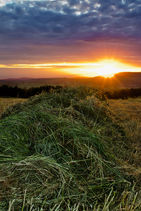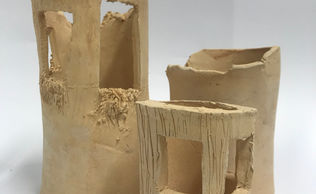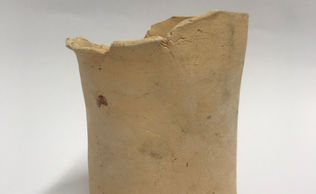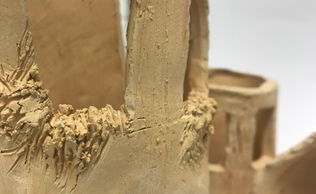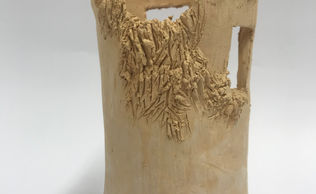
Teaching Practice
Visual Arts in the Classroom
"Education is not preparation for life; education is life itself "
– John Dewey
The aim of the Visual Arts for the Classroom modules is that each student develops appropriate levels of understanding of processes and application of skills in the 2D and 3D domains.
The experience can then be translated to the classroom and the work becomes visual aids.
Drawing & Painting VAC
Nationhood
Jack B Yeats & Lucian Freud
This VAC stemmed from an IMMA exhibition called Life Above Everything which featured work by Lucian Freud and Jack B Yeats. Freud's work is has been lent to IMMA and the curators of IMMA find artists to be displayed alongside the work to create a new dialogue.
We visited IMMA and the National Gallery of Ireland's archives where we viewed Yeats Notebooks.4 themes are embedded in the project. The Outsider, Beneath the Surface, Beyond the Frame and Nationhood. We viewed the work and picked one theme that spoke to us. I picked Nationhood, as I was interested in identity, legacy and connection to places.
The Leaving Cert framework of Respond, Research and Create were engaged with. We created an Artists Notebook and a Teacher Notebook that we now use to enhance our teaching.
My response was inspired by the primary sources I gathered from my Families Land in Wexford. I dug into build ditches to find rusty found objects. One piece was a wheel from my Father's pram. This act was inspired by George Muncey's photographs.




Primary Sources




Freud & Yeats




Images from the Artist Notebook




Teacher Notebook
Print VAC
Nationhood
Aim:
Learning different printing techniques and produce a body of work that can be resourceful teaching material. Experiment with colour mixing. Transform a drawing from the previous vac and create a new image.
Learning Objectives:
-
Plan and construct a Collagraph.
-
Plan a composition and transfer it to Lino plate.
-
Suggest light and shade through mark making on Lino plate. Suggest texture through dynamic cuttings on Lino plate.
-
Find new ways of inking and pulling prints.
-
Identify Artists from Art History and Contemporary practice who have worked in the Lino, Woodblock tradition, or Collagraph technique.
-
Compare and contrast Printmakers from Art History and Contemporary Practice.
Art Elements and Design Principles investigated were compositions, tone, pattern and texture.
Printing techniques: Collagraphs, Chine Collé and Lino Printing.

Print Notebook




Lino Printing




Collagraph Prints
Clay VAC
Journey/ Narrative
Theme: Journey/ Narrative in 3D forms
Aim:
-
To research and explore a theme addressing 3D form in clay.
-
To develop skills in idea generation and the use of materials, tools and techniques.
-
Use both the interior and exterior of the form/s to create a visual narrative.
-
Think about space/ spaces, examining the potential of varied multiples and texture, i.e. subdividing/altering the interior of a given form and using texture that corresponds
Guided questions:
-
Keep the forms simple - consider the making time.
-
Try to engage in the playful potential of this theme.
-
Try to engage with the material and it’s soft, forming potential.
Skills:
-
Sketching and designing.
-
Investigating textures and producing textured tiles.
-
Building pinch pots and slab boxes.
-
Constructing free forms.
-
Firing process, using the Kiln.
-
Slip.
My Inspiration:
Texture plays an important element of working with clay. I took inspiration from the textures found on a farm. For example, feed, tractor tyres, animal hair and green fields. The textured tiles were made from pressing cow hairs, tried cow pats and tools from the farm.
The free form sculptures resemble rusty and used ring feeders. They are worn, parts have rusted off allowing the silage to spill through. The organic shapes show the deconstruction of time. Once fired, my feeders transformed into a ceramic response to the theme Journey.

Clay Notebook
Inspiration photographs: Taken on my family farm




Textured tiles
Clay before firing in the Kiln




Personal designs
Clay before firing in the Kiln
Final clay sculpture
Fired in the kiln, unglazed
3D Cardboard
Construction VAC
The Toolboard Board




Theme: The Tool Board
Aim:
Explore the creative potential of cardboard as a 3D construction material. Create a Unit of Learning. Engage in research, design, construction and a digital notebook. Our own artist/ designer practice influenced what tools we constructed.
Stages:
-
Research
-
Design
-
Construction
-
Presentation
Learning Outcomes:
-
Identify relevant and appropriate artists work to support research, design and construction stages of the VAC.
-
Use drawing to analyse, investigate, plan and record visual information.
-
Breakdown, simplify and render structure as a set of geometric shapes and forms.
-
Experiment with a variety of cardboards to make three-dimensional forms.
-
Explore surface quality and texture through the manipulation of card.
-
Employ a variety of joining techniques to combine forms.
-
Construct a scaled replica of source object using cardboard.
-
Propose a brief outline of a related Lesson Scheme appropriate to the classroom.
-
Record the research, design and construction process in a digital notebook.





